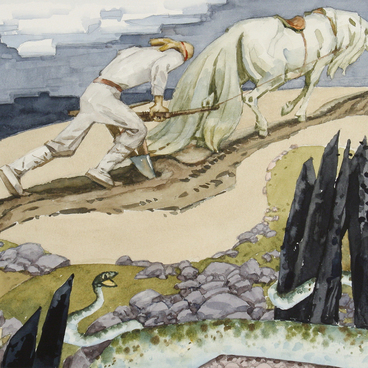Yuri Konstantinovich Lyukshin was born in 1949 in Leningrad. He graduated from the Valentin Serov Art College in 1971. He is a graphic artist, painter, book illustrator, art historian, teacher, and organizer of children’s art competitions. He founded a charity program for children called “Paints of Kindness”. Lyukshin has been a member of the Russian Union of Artists since 1978, the International Association of Art Historians since 1998, and an Honored Artist of Russia since 2007. He has participated in over 300 exhibitions in Russia and abroad. He had 70 solo exhibitions. Lyukshin works in a variety of mediums, including oil painting, watercolor, pastel, gouache, etching, aquatint (engraving on metal), and lithography.
Lyukshin first depicted the world of “Kalevala” in 1985, creating his first easel lithographs and bookplates. The artist was so captivated by the beauty of the poetic language, the depth of characters, the ethnographic richness of the archaic world, the complex philosophy of paganism, and the eventual conversion to Christianity, that he continued working with the epic for many years.
Yuri Lyukshin uses a fine, filigree etching technique followed by hand coloring. Since 1985, he has been creating Kalevala-themed series that not only reflect the main characters, events, and plot of the narrative, but also symbolism associated with the universe of Kalevala.
Wainamoinen sends Sampsa Pellerwoinen to fetch a
tree for a boat. He crafts a boat from this wood using spells, but is unable to
complete its construction because he does not know the last three words.
Wainamoinen goes to Antero Wipunen for the words and awakens him from a long
slumber underground. The issue of creation becomes the central theme for
Wainamoinen, as he is the first human and has to create all necessary objects
for himself. The wisdom he accumulated in his mother’s womb does not always aid
in completing his tasks. Elias Lönnrot continuously guides the plot of the poem
in a manner that makes Wainamoinen seek out more and more words, thus weaving a
vast amount of folklore he collected into the narrative. One such plot twist is
the encounter with a character from the archaic myth of the giant Wipunen
(Vipunen), who is rooted in the ground.


